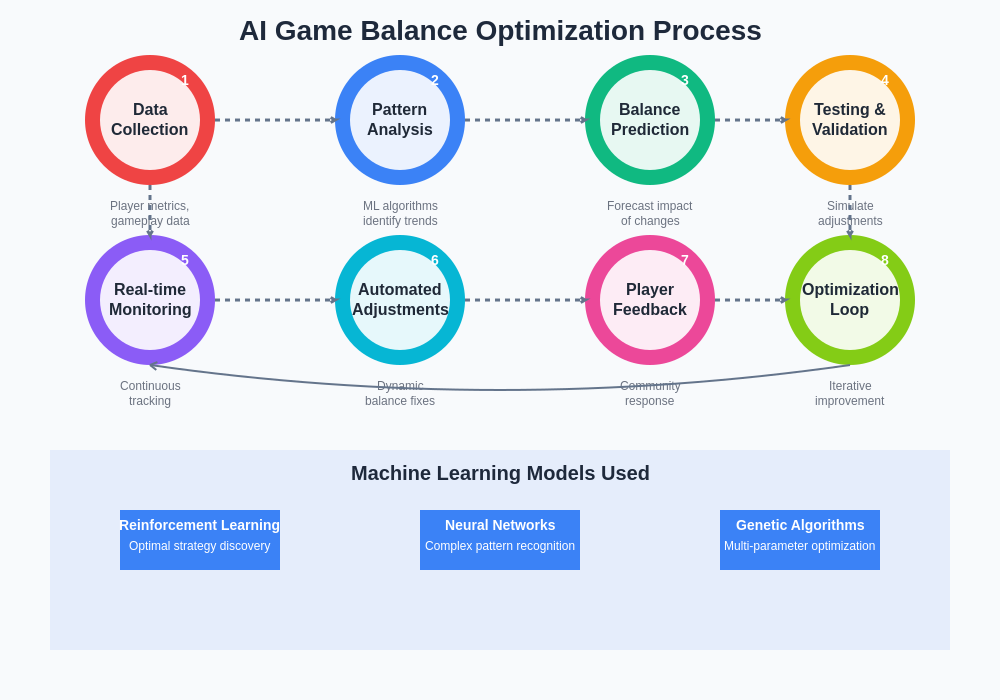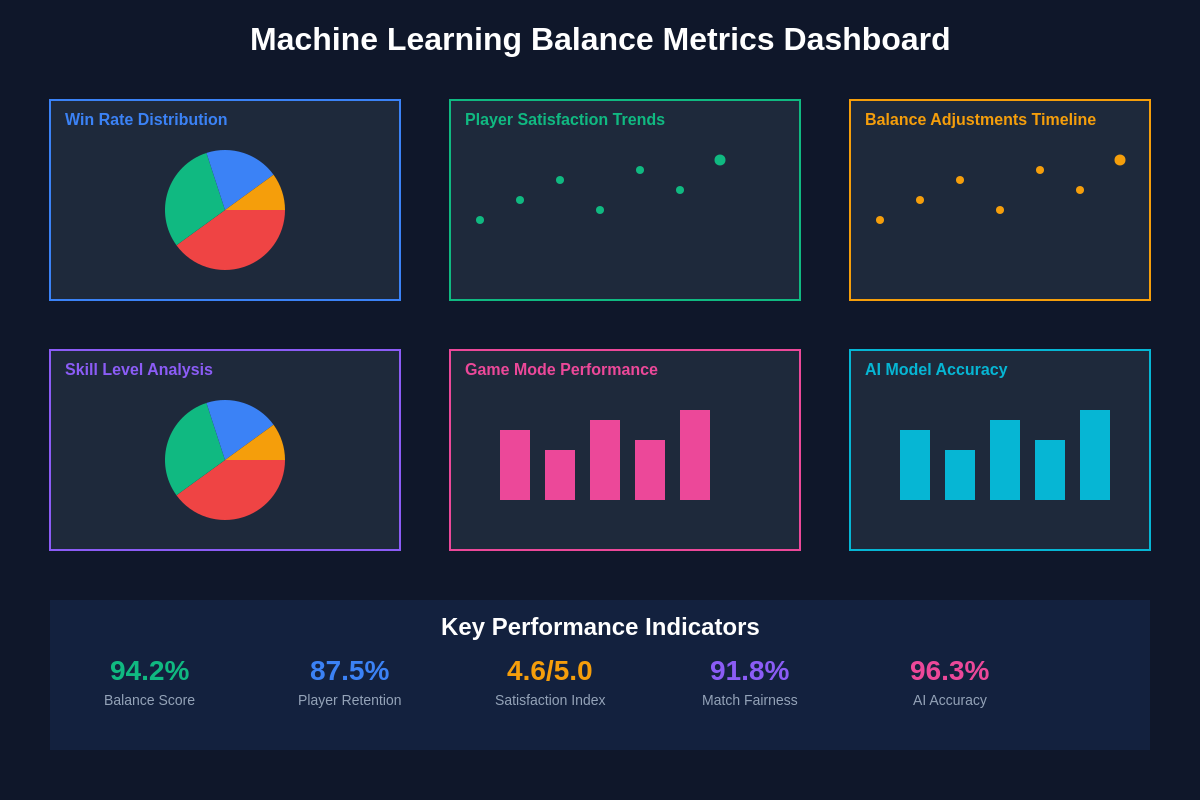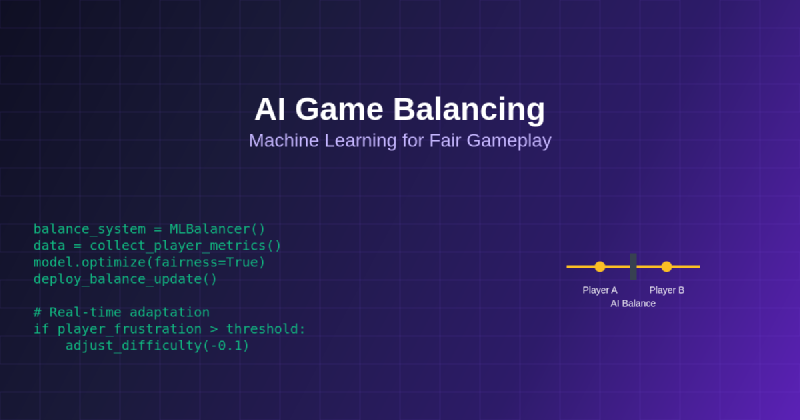The gaming industry has witnessed a revolutionary transformation in how developers approach game balance, moving from traditional manual tuning methods to sophisticated artificial intelligence and machine learning systems that continuously optimize gameplay experiences. This paradigm shift represents one of the most significant advances in game development, enabling the creation of dynamic, responsive gaming environments that adapt to player behavior patterns and ensure fair, engaging experiences across diverse player skill levels and preferences.
Explore the latest AI gaming innovations to understand how machine learning is reshaping not just game balance but the entire gaming landscape. The integration of AI into game balancing systems has opened unprecedented possibilities for creating self-regulating gaming ecosystems that maintain optimal challenge levels while preserving the fundamental enjoyment that keeps players engaged and invested in their gaming experiences.
The Evolution of Game Balancing Methodologies
Traditional game balancing relied heavily on developer intuition, extensive playtesting sessions, and iterative manual adjustments based on limited feedback from small testing groups. This approach, while functional for simpler games with fewer variables, proved inadequate for modern complex gaming systems with thousands of interconnected mechanics, diverse player populations, and real-time multiplayer environments where balance issues could dramatically impact player satisfaction and retention rates.
The introduction of machine learning algorithms into game balancing has fundamentally transformed this process by enabling systems to analyze vast amounts of player data, identify patterns in gameplay behavior, and automatically adjust game parameters to maintain optimal balance conditions. These AI-driven systems can process millions of gameplay sessions, track player performance metrics, and implement precise adjustments that would be impossible to achieve through manual balancing methods alone.
Modern AI balancing systems utilize sophisticated statistical models that account for player skill distributions, weapon effectiveness ratios, character ability interactions, and environmental factors that influence gameplay outcomes. This comprehensive approach ensures that balance adjustments are based on empirical data rather than subjective interpretations, resulting in more accurate and effective modifications that improve overall gameplay quality.
Machine Learning Algorithms in Game Balance
The application of machine learning to game balancing employs various algorithmic approaches, each suited to different aspects of gameplay optimization. Reinforcement learning algorithms excel at discovering optimal strategies and identifying exploitative gameplay patterns that might emerge from certain game configurations. These systems can simulate millions of gameplay scenarios, testing different balance parameters and evaluating their impact on player experience metrics such as engagement duration, win-rate distributions, and satisfaction scores.
Neural networks have proven particularly effective for analyzing complex player behavior patterns and predicting how balance changes might affect different player segments. Deep learning models can process multidimensional gameplay data, identifying subtle correlations between game mechanics, player actions, and satisfaction outcomes that human designers might overlook. This capability enables more nuanced balance adjustments that consider the intricate relationships between different game systems.
Discover advanced AI tools like Claude for developing sophisticated game balancing algorithms that can process complex datasets and generate actionable insights for game improvement. The combination of powerful AI systems with game development expertise creates opportunities for unprecedented precision in gameplay optimization and player experience enhancement.
Genetic algorithms represent another powerful approach to game balancing, particularly effective for optimizing multiple interconnected game parameters simultaneously. These systems can evolve balance configurations over time, testing different parameter combinations and selecting those that produce the most desirable gameplay outcomes. This evolutionary approach to balance optimization ensures that game systems continuously improve rather than remaining static after initial implementation.
Real-Time Adaptive Balance Systems
One of the most significant advantages of AI-powered game balancing lies in its ability to implement real-time adaptive adjustments that respond immediately to emerging gameplay patterns and player behavior changes. Traditional balancing methods required lengthy update cycles, during which problematic balance issues could persist and negatively impact player experiences. Modern AI systems can monitor gameplay metrics continuously and implement micro-adjustments that maintain optimal balance conditions without requiring major game updates or patches.
These adaptive systems excel at managing dynamic gaming environments where player populations, skill levels, and strategic approaches evolve continuously. By analyzing real-time gameplay data, AI balancing systems can identify when certain strategies become overpowered, when player engagement drops in specific game modes, or when new exploitative behaviors emerge that threaten fair gameplay. The system can then implement targeted adjustments that address these issues while minimizing disruption to players who are not affected by the problematic behaviors.
The implementation of real-time balancing requires sophisticated monitoring infrastructure that can collect, process, and analyze gameplay data at scale. Modern AI systems utilize cloud computing resources to handle the massive data processing requirements while maintaining low-latency response times that enable immediate balance adjustments when necessary.
Player Behavior Analysis and Prediction
Understanding player behavior patterns represents a crucial component of effective AI game balancing, as optimal balance configurations must account for how different player types interact with game systems. Machine learning algorithms can segment players based on their gameplay patterns, skill progression trajectories, and engagement preferences, enabling the creation of balance systems that provide appropriate challenges and rewards for diverse player populations.
Predictive analytics play an essential role in anticipating how balance changes might affect different player segments before implementation. By analyzing historical data and player response patterns, AI systems can forecast the likely impact of proposed balance adjustments, identifying potential negative consequences and suggesting alternative approaches that achieve desired balance goals without creating new problems.
Advanced behavior analysis systems can identify subtle indicators of player frustration, boredom, or disengagement that might result from balance issues. These systems can detect when players are struggling with overly difficult challenges, becoming bored with insufficiently challenging content, or experiencing unfair gameplay situations that diminish their enjoyment. This early detection capability enables proactive balance adjustments that address issues before they significantly impact player satisfaction and retention rates.
Competitive Gaming and Esports Balance
The rise of competitive gaming and esports has created unprecedented demands for precise game balance that ensures fair competition among players at the highest skill levels. AI balancing systems have become essential tools for managing competitive gaming environments where even minor balance discrepancies can significantly impact tournament outcomes and professional player careers. These systems must account for the complex interactions between high-level player strategies, team compositions, and mechanical execution that characterize competitive play.
Machine learning algorithms designed for competitive balance focus on analyzing professional gameplay data, identifying emerging meta-game trends, and predicting how balance changes might affect competitive strategies. These systems must balance the need for strategic diversity against the requirement for fair competition, ensuring that multiple viable approaches remain competitive while preventing any single strategy from becoming overwhelmingly dominant.

The optimization process for competitive game balance involves continuous monitoring of professional matches, analysis of pick-and-ban patterns, win-rate tracking across different skill levels, and correlation analysis between game changes and competitive outcomes. This comprehensive approach ensures that balance adjustments support healthy competitive environments where skill and strategy determine success rather than exploitative game mechanics or unbalanced character abilities.
Player Satisfaction and Retention Optimization
AI game balancing systems increasingly focus on optimizing player satisfaction and retention metrics rather than solely pursuing mathematical balance perfection. Research has demonstrated that perfectly balanced games are not necessarily the most enjoyable, as players often prefer experiences that provide varied challenges, opportunities for growth, and moments of exceptional performance. Modern AI systems must balance mathematical fairness with psychological engagement factors that drive long-term player investment.
Machine learning algorithms can identify the optimal challenge curves that maintain player engagement without creating excessive frustration or boredom. These systems analyze player progression patterns, identifying points where players typically experience difficulty spikes or engagement drops, and implement balance adjustments that smooth these transitions while preserving the sense of achievement that comes from overcoming challenges.
The relationship between game balance and player retention involves complex psychological factors that AI systems must consider when implementing balance changes. Players who feel that their time investment is respected, that improvement is possible through skill development, and that victory results from fair competition are more likely to remain engaged with the game over extended periods.
Enhance your research capabilities with Perplexity to stay updated on the latest developments in player psychology, engagement metrics, and retention optimization strategies that inform modern AI game balancing approaches. Understanding these human factors is crucial for developing AI systems that create genuinely satisfying gaming experiences.
Technical Implementation Challenges
Implementing AI-powered game balancing systems presents numerous technical challenges that developers must address to create effective, reliable balance management solutions. Data collection infrastructure must be capable of gathering comprehensive gameplay metrics without impacting game performance or player privacy. This requires sophisticated data pipeline architectures that can process real-time gameplay streams while maintaining strict security and privacy standards.
The complexity of modern games creates additional challenges for AI balancing systems, as these systems must account for thousands of interacting variables, player preferences, and emergent gameplay patterns that may not be immediately apparent. Machine learning models must be trained on representative datasets that capture the full diversity of player experiences while avoiding bias toward specific player populations or gameplay styles.
Model validation and testing represent critical aspects of AI balancing implementation, as incorrect balance adjustments can significantly impact player experiences and game success. Developers must establish robust testing frameworks that can evaluate proposed balance changes across multiple scenarios, player types, and gameplay conditions before implementing changes in live gaming environments.
Integration with Game Development Workflows
The successful integration of AI balancing systems into game development workflows requires careful coordination between AI specialists, game designers, and development teams. Traditional game development processes must be adapted to accommodate continuous balance monitoring and adjustment capabilities while maintaining creative control over fundamental game design decisions.
AI balancing systems must be designed to complement rather than replace human game design expertise, providing data-driven insights and optimization suggestions that inform design decisions rather than automatically implementing changes without human oversight. This collaborative approach ensures that AI-driven balance improvements align with overall game vision and design goals while leveraging the analytical capabilities that AI systems provide.
The development of effective AI balancing systems requires interdisciplinary expertise combining game design principles, machine learning techniques, statistical analysis, and player psychology understanding. Teams must develop new methodologies for evaluating balance system effectiveness and establishing success metrics that account for both mathematical balance measures and player satisfaction indicators.
Data Privacy and Ethical Considerations
The implementation of AI game balancing systems raises important questions about data privacy, player consent, and ethical use of player information for game optimization purposes. Developers must establish transparent data collection practices that clearly communicate how player data is used for balance optimization while providing options for players who prefer not to participate in data collection programs.
Algorithmic fairness represents another crucial ethical consideration, as AI balancing systems must avoid creating discriminatory outcomes that disadvantage certain player populations based on demographics, geographic location, or other factors unrelated to gameplay skill or behavior. Balance systems must be designed to promote inclusivity and equal opportunity for enjoyment across diverse player communities.
The potential for AI systems to manipulate player behavior through balance adjustments raises ethical questions about the extent to which games should attempt to optimize player engagement through algorithmic means. Developers must balance the goal of creating engaging experiences with respect for player autonomy and transparent communication about how AI systems influence gameplay experiences.

Modern balance systems require sophisticated monitoring dashboards that track multiple metrics simultaneously, enabling developers to understand the complex relationships between different balance parameters and their effects on player experiences. These visualization tools are essential for maintaining oversight of AI balancing systems and ensuring that automated adjustments align with design intentions.
Future Innovations and Emerging Trends
The future of AI game balancing promises even more sophisticated approaches to gameplay optimization, including the integration of natural language processing systems that can analyze player feedback and social media discussions to identify balance issues that might not be apparent from gameplay metrics alone. These systems could provide more comprehensive understanding of player experiences and concerns that inform balance decisions.
Advanced AI systems may eventually enable personalized game balancing that adapts to individual player preferences and skill levels, creating customized gameplay experiences that maintain appropriate challenge levels for each player while preserving competitive fairness in multiplayer environments. This personalization could extend to dynamic difficulty adjustment systems that provide optimal challenge levels throughout gaming sessions.
The integration of AI balancing systems with other game development tools, including procedural content generation and player behavior prediction systems, could enable the creation of fully adaptive gaming experiences that evolve continuously based on player interactions and feedback. These integrated systems could represent the next major evolution in game development methodology.
Cross-game learning represents another promising area for AI balancing development, where systems could apply lessons learned from one game’s balance optimization to improve balance in other games with similar mechanics or player populations. This knowledge transfer could accelerate the development of effective balance systems and reduce the time required to achieve optimal balance in new games.
The continued advancement of machine learning techniques, including the development of more interpretable AI models and improved handling of complex multi-objective optimization problems, will enhance the effectiveness and reliability of AI balancing systems while making them more accessible to game development teams with varying levels of AI expertise.
Industry Impact and Adoption Trends
The gaming industry’s adoption of AI balancing systems has accelerated significantly as developers recognize the competitive advantages provided by data-driven balance optimization. Major gaming companies have invested heavily in AI research and development teams focused specifically on game balancing applications, leading to rapid advancement in both theoretical understanding and practical implementation capabilities.
Independent game developers increasingly have access to AI balancing tools and services that were previously available only to large studios with substantial technical resources. Cloud-based AI services and open-source machine learning frameworks have democratized access to sophisticated balancing capabilities, enabling smaller development teams to implement advanced balance optimization systems in their games.
The success of AI-balanced games in maintaining player engagement and satisfaction has created industry-wide recognition of the importance of data-driven balance management. This recognition has led to increased investment in player analytics infrastructure, AI research partnerships, and the development of specialized tools and platforms designed specifically for game balancing applications.
The gaming industry continues to evolve its understanding of how AI balancing systems can be most effectively utilized, with ongoing research into optimal implementation strategies, player communication approaches, and integration methodologies that maximize the benefits of AI-driven balance optimization while minimizing potential drawbacks or player concerns about algorithmic game management.
Conclusion and Strategic Recommendations
The integration of artificial intelligence and machine learning into game balancing represents a fundamental shift in how the gaming industry approaches gameplay optimization and player experience management. The evidence clearly demonstrates that AI-powered balancing systems can achieve levels of precision, responsiveness, and effectiveness that far exceed traditional manual balancing methods while enabling the creation of more engaging and satisfying gaming experiences.
Successful implementation of AI balancing systems requires careful attention to technical infrastructure, ethical considerations, player communication, and integration with existing development workflows. Developers who invest in developing comprehensive AI balancing capabilities will be well-positioned to create games that maintain optimal balance conditions, maximize player satisfaction, and adapt effectively to evolving player behaviors and preferences.
The future of game development will likely see AI balancing systems become standard components of game development toolchains, with continued innovation in algorithmic approaches, data analysis techniques, and integration methodologies that further enhance the effectiveness of these systems. The gaming industry’s continued evolution toward data-driven development practices ensures that AI balancing will remain a crucial area of investment and innovation for developers seeking to create exceptional gaming experiences.
Disclaimer
This article is for informational purposes only and does not constitute professional advice regarding game development or AI implementation. The views expressed are based on current understanding of AI technologies and their applications in game balancing. Readers should conduct their own research and consider their specific requirements when implementing AI-powered game balancing systems. The effectiveness of AI balancing systems may vary depending on specific game types, player populations, and implementation approaches. Game developers should carefully evaluate the suitability of AI balancing systems for their particular projects and consult with relevant experts when designing and implementing such systems.
